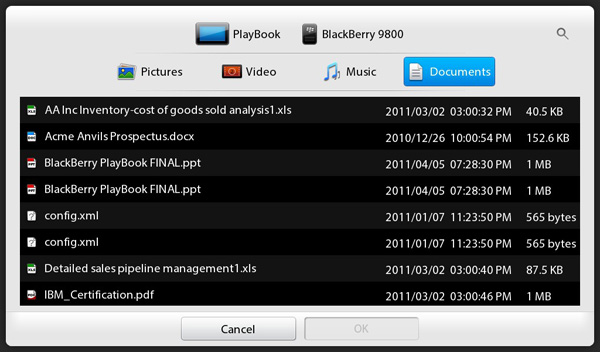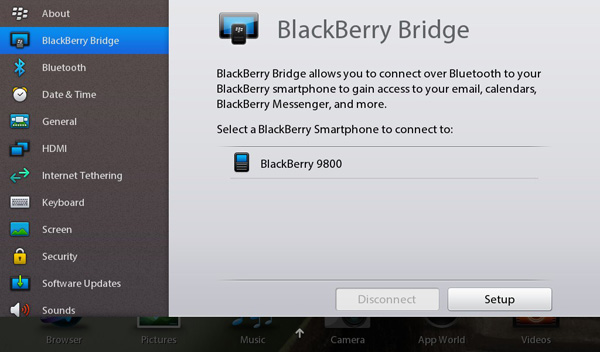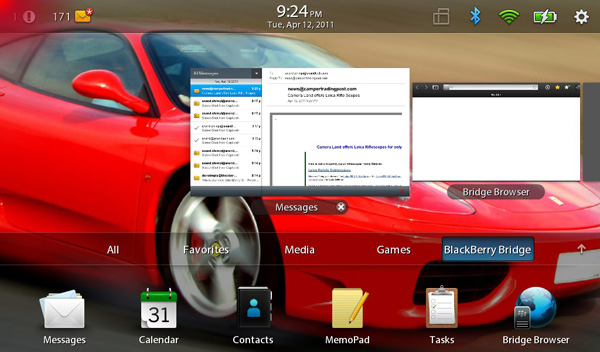The BlackBerry PlayBook Review
by Anand Lal Shimpi on April 13, 2011 9:00 PM EST- Posted in
- Tablets
- Smartphones
- RIM
- BlackBerry
- PlayBook
- Mobile
BlackBerry Bridge
The first era of the mobile revolution was about apps. Quantity, quality, method of delivery, everything that related to the apps on these devices is what really helped accelerate adoption of platforms like Android and iOS. While we're not quite done with the first era, the next era will be one of synergy between devices. Today there's simply no good way to seamlessly share all of your data (both static and active) among all of your computing devices (PC, tablet and smartphone). Cloud services help bridge the gap but what about some of the basic use cases? Let's say I've got a few tabs open in Chrome on my PC and I decide to take a break and read those websites on my tablet. There's no way to quickly take my current operating environment with the apps/tasks I've got open and transition them to another device.
Everyone who is anyone in the mobile space is working on device synergy, although very few attempts have been demonstrated publicly. HP's touch-to-share is an early example of synergy between devices, although it's presently limited to sharing URLs between webOS phones and the TouchPad. You can see how HP is in a good position however to extend that sort of synergy to its desktops as well. The same goes for Apple. Google wouldn't have too hard of a time doing it, assuming you're running mostly web apps on your PC and store state in the cloud.
RIM's first attempt at device synergy targets its loyal (whether forced or by choice) customer base: BlackBerry users. In the enterprise, the BlackBerry does a handful of things extremely well. The features are apparently attractive enough to actually force some users to carry two smartphones: an iPhone/Android phone for personal use and a BlackBerry for work.
The PlayBook solution is called BlackBerry Bridge. At a high level it's a 256-bit AES encrypted link over Bluetooth between the tablet and any BlackBerry running OS 5.0 or later. This encrypted link is then used to manage data stored on the BlackBerry using the PlayBook. In essence, the PlayBook becomes a larger window into your BlackBerry.
To enable BlackBerry/PlayBook interoperability you have to do two things. First, on the PlayBook, go to the BlackBerry Bridge settings page and enable the option. You'll be taken through steps to get the Bridge app onto your BlackBerry and finally pair the two devices. RIM just enabled Bridge support within the past 24 hours so the process is a bit more complicated for reviewers than it will be for customers. While an end user should be able to just scan the QR code displayed on the PlayBook with a BlackBerry, I had to login to RIM's beta site and manually download the app as well as jump through a few additional hoops.

The pairing process is pretty simple, pretty typical for a Bluetooth pair. You'll get a pin on both devices, make sure they match, hit go and you're all synced up.

Once paired, you can lock your BlackBerry and set it aside. The PlayBook now gives you full access to messages, calendar, contacts, memos, tasks and even your BIS/BES connection for browsing the web. Again, the link between the BlackBerry and PlayBook is 256-bit AES encrypted so you don't sacrifice any security in doing this.
The default PlayBook home screen has four categories for apps: All, Favorites, Media and Games. Enabling Bridge adds a fifth category: BlackBerry Bridge. All apps in this category pull their data from your BlackBerry and don't store anything on the PlayBook itself. Once you end the Bridge session, all data goes away. Even when you're using the PlayBook anything that comes from your BlackBerry is stored temporarily in memory and encrypted during its stay on the tablet. RIM's goal here is to allow the PlayBook to be introduced into a secured enterprise environment without compromising that security.
All internet/intranet data you access through a BlackBerry Bridge app goes over your BlackBerry internet connection, which means it all goes through BIS/BES and is thus fully encrypted. There's obviously a performance penalty, but if you need the added security, it's there.
BlackBerry Bridge apps are all choppier than regular PlayBook apps, something you notice even when you scroll over them in the task switcher. Scrolling over PlayBook apps is typically pretty smooth but get to the first active Bridge app and the animation frame rate drops a bit.
BlackBerry Bridge Messages
By default the PlayBook has no thick email client, something RIM will rectify this summer in an update to the PlayBook OS. BlackBerry Bridge however gives you full access to all messages received by your BlackBerry via the Messages app.
The Messages UI is pretty standard for a tablet email client. There are two columns, one for your inbox and one for the currently selected message. In portrait mode only one column is visible at a time.
You can do most of the basics from the Messages app: search, compose, delete, forward, reply, flag and move. Curiously absent is the ability to mark all items as opened like you can on a BlackBerry. You can go into multiple-selection mode just like on Android/iOS and mark items as opened that way, but there's no mark all option unfortunately.

You can send attachments via Bridge from either the PlayBook or BlackBerry, but you can't open them currently
Selecting multiple items in the Messages app is considerably slower than other aspects of the PlayBook UI. Given how fast and smooth everything else is, any sluggishness is that much more pronounced.
Calendar, Contacts, MemoPad and Tasks
The Bridge Calendar app isn't particularly beautiful, but it's functional. You can create and view appointments, which are again stored only on your BlackBerry. Unfortunately any reminders set in your calendar don't currently propagate to the PlayBook, they'll appear on your BlackBerry but not on the tablet. RIM clearly has work to do here.
The Contacts, MemoPad and Tasks apps are all self explanatory. Any data you create/access here lives solely on the BlackBerry, the PlayBook is simply a more user friendly viewport into your work world.
The notification problem exists for the Tasks app as well. You can have a reminder set for a task but you'll only be notified on your BlackBerry.
BlackBerry Bridge Browser
Remember that all Bridge apps use your BlackBerry's encrypted internet connection to get to the outside world. If you need that added layer of security for web browsing, just fire up the Bridge Browser.
The Bridge Browser app itself is just as functional as the standard PlayBook browser. You can even run the PlayBook's browser and the BlackBerry Bridge browser in parallel, using one for unencrypted web traffic and the other when you need additional security. The only difference between the two browsers is what path your packets take: WiFi or Bluetooth-to-BlackBerry-radio.












77 Comments
View All Comments
Andrew911tt - Thursday, April 14, 2011 - link
You have the Xoom at a price of $799 but you can get the 32 GB wifi version for $599http://www.amazon.com/MOTOROLA-XOOM-Android-Tablet...
MTN Ranger - Thursday, April 14, 2011 - link
Excuse my off topic question.Anand, I notice you use Lafayette Village in your videos a lot. Do you live/work near there? We enjoy having drinks at the Village Grill and my wife loves the Upper Crust Bakery. I have taken photos there and think the architecture is great.
Anand Lal Shimpi - Thursday, April 14, 2011 - link
I'm not too far from there. It's the most interesting thing that I can photograph quickly outside of my dogs playing :)Take care,
Anand
jensend - Thursday, April 14, 2011 - link
I'm serious- this is probably the best commercial OS out there. Of course, these days most people judge an OS mostly by its included applications and the collection of software written for it, which doesn't look so good for QNX, but as far as the actual OS is concerned QNX is extremely well designed.baba264 - Friday, April 15, 2011 - link
I would tend to agree.I was very impressed upon reading all the nice features that this OS has and that are still lacking in mainstream PC OS.
The the tight kernel, the sandboxing, the thread management, the corruption protection all of it sounded real nice. Of course since it wasn't the focus of the article, many question remain, especially performance wise, still it sounded like an impressive work.
vision33r - Friday, April 15, 2011 - link
Because people are used to the iPhone / iPad and App Store being the standard.QNX is a good OS, it is tight and lean. There won't be a fragmentation problem like Android has.
The only problem is that RIM will restrict the device's functionality so that it cannot replace a Blackberry device and risk losing lucrative smartphone sales.
B3an - Friday, April 15, 2011 - link
"You can't really hover to expose controls with a touchscreen so what you end up doing is a lot of quick tapping to try and bring up controls, change the setting you want and get back to playing the video. It's frustrating and doesn't work all of the time. None of this is RIM's fault, but now that tablets are at the point where they can start to behave like notebook/desktops web developers will have to rethink the way they build websites. "I'm a web designer and specialise in interactive websites and apps, but touch screens have the ability to hold this area back and make it less elegant/messy for other devices with no touch.
The problem is not with web sites designed for non-touch devices but the need for a touch device to support hover in some way. For instance this could be done if a touch screen could detect a finger hovering over an area of the screen within say half an inch of the screen surface. That could work well if done right.
As sites get more interactive and advanced hover controls in the UI make more and more sense. because of interface complexity rises and the need for more buttons and stuff all over the place.
The thing with Flash is that being as it's far more capable than HTML5 for interaction (and with pretty much anything else too) is that it's Flash that is more likely to use hover controls in some form. But some HTML5 things are stating to use it, like the default skinned Chrome HTML5 video player for instance. Hover just makes perfect sense for certain things and touch screens need to fix this, not us web designers.
ElementFire - Friday, April 15, 2011 - link
This is a seriously well-wrought review. I'm especially glad you dedicated an entire section to Bridge, and addressed the free tethering question. As you stated, this is huge (assuming the carriers permit it), as it's the closest thing to truly unlimited browsing data plans (for no additional charge!) as we'll get now.It's a pity that Android apps need to be re-signed by RIM before they'll run. It makes sense from a security perspective (you don't want malicious apps running amok on an enterprise platform), but I'd have preferred if RIM had severely limited Android VM capability and allowed all apps to *try* to run, rather than requiring re-signing; the vast majority of Android app-developers won't have the impetus to resubmit their apps to yet another platform holder.
The last point I wanted to make was video conferencing: it's a serious letdown to only ship with point-to-point video chat (and even then, only between PlayBook owners!). If you're aiming at the enterprise, I'd expect VoIP/SIP capability and the ability to run WebEx natively. Does the PlayBook support any implementation of Java Runtime Environment?
name99 - Saturday, April 16, 2011 - link
"Pretty much no smartphone or tablet we've tested is particularly speedy over WiFi. Even the Motorola Xoom, at the top of our performance chart, manages a meager 36Mbps. Part of this has to do with the fact that all of these devices are power rather than performance optimized and part of it has to do with NAND performance limitations."Is this not simply a reflection that none of these devices use 40MHz wide channels, they all stick to 20MHz wide channels? I'm not certain about this, but given how the numbers cluster, I would bet this is the case.
(And, of course, none of these devices use multiple antennas for wifi.)
The flash has nothing to do with it. iPad flash can write sustained at a little under 20MB/s (ie 160 Mbs/s) and I imagine other tablets have similar specs.
In theory, the most power efficient way to run wifi is to do get your transmissions done as fast as possible --- in other words use 40MHz and multiple antennas and run at the maximum data rate possible. Of course this requires that the chips being used be maximally efficient in their overhead, so that essentially all power is being burned in RF transmit, not in the receivers, the decode logic and so on. It may well be that the chips supporting 40MHz, let alone MIMO, simply haven't been around for long enough to have their power usage tuned to where the 20MHz chips are.
tipoo - Sunday, April 17, 2011 - link
Most routers and laptops will default to 20MHz anyways.